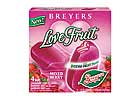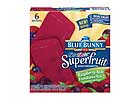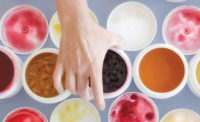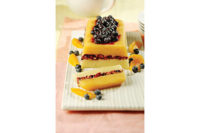
McDonald’s has a Yogurt n’ Fruit Parfait . . . for a dollar. Airport kiosks around the country sell their own version for about five times that price. And, consumers buy them. Consumers recognize such products are a great way to get your 3-A-Day of Dairy with your 5-A-Day The Color Way . . . all-in-one.
Dairy processors recognize this opportunity, too. Take for example, Le Mars, Iowa-based Wells’ Dairy Inc.’s new Superfruit offerings. There’s something new in the freezer and the refrigerator. Under its Blue Bunny brand in the fridge, Wells’ Dairy introduces an improved version of its Lite 85 yogurt: Lite 85 Superfruit yogurt.
“Lite 85 Superfruit yogurt contains unique fruit combinations that are natural sources of antioxidants,” says Kent McCuddin, manager of consumer communications for Wells’ Dairy. “This feature appeals to consumers who want the hottest new flavor combinations in a light yogurt, with the added benefits of antioxidants.”
The six flavors of Lite 85 Superfruit yogurt are Black Currant, Pomegranate Blueberry, Pomegranate Cherry, Rasp-berry Açai, Raspberry Cranberry and White Cranberry Strawberry. Already a good source of calcium and protein, Lite 85 products also recently got a boost through the inclusion of probiotic cultures, which are recognized for enhancing the body’s immune system and improving digestive health.

Packages of new Breyers Love Fruit Bars tout the fact that they are made with the real stuff: fruit puree and fruit juice.
In the freezer, there’s Blue Bunny FrozFruit Superfruit. These non-dairy bars come in two varieties:
Pomegranate Cherry and Raspberry Açai. Because fruit bars are a very common frozen novelty among the Hispanic population, packages are bilingual. And again, the company is leveraging the fact that the bars are a concentrated source of high-antioxidant-containing fruit ingredients.
Touting fruit content of foods is becoming more common. Though not a dairy food, here’s a unique product worth noting. Frito-Lay Inc., Plano, Texas, a division of PepsiCo, Purchase, N.Y., has rolled out a line of baked crisp snacks under the brand Flat Earth, which contain either a half-serving of fruit or vegetable per individual ounce of crisps. The baked fruit crisps-Peach Mango Paradise-are a unique blend of rice, potato, apple, peach and mango. (By the way, they are VERY good.)
Getting one’s 5-A-Day The Color Way includes veggies. Those new chips also come in two veggie formulations. Same story: an individual ounce of either Tangy Tomato Ranch or Farmland Cheddar contains a half-serving of vegetables.
Combining fruits and vegetables and adding them to dairy foods is a trend that is becoming prevalent overseas. Italy’s Granarolo Spa dairy manufactures a line of low-fat yogurts that claims to contain one serving of fruit and one of vegetable. The unique combinations are Apple & Spinach, Blueberry & Carrots, Mango & Pumpkin, Pineapple & Fennel and Strawberry & Tomato.

Forms of fruit ingredients
There are numerous forms of fruit ingredients from which dairy formulators can choose. In general, the more “whole” or “natural” the fruit is, the better the perception of its quality to today’s health- and wellness-seeking consumer.For piece identity, as in the case of cup yogurt or a frozen dessert, a good choice is individually quick frozen (IQF) fruit, which contains no added sugar or preservatives. IQF fruit tends to readily separate, making it easy to weigh out the quantity during product manufacturing. IQF fruits should be thawed prior to addition to a formulation.
Another “whole” fruit option is infused frozen fruit. Unlike IQF, infused fruits do contain some added sugar as well as natural stabilizing agents in order to bind and control the free water in the fruit pieces. This inhibits ice crystal formation and results in a fruit ingredient that does not completely freeze in an application such as ice cream. The fruit pieces remain soft and scoopable, while retaining fruit piece identity and natural color.

Blue Bunny Superfruit products highlight the fact that they contain high-antioxidant-containing fruits.
If whole pieces are not a priority, bases, purees and concentrates are all excellent choices. Most of the time these ingredients contain no added sugar, but because they are concentrated sources of the fruit, they still have a high percentage of sugar, which is measured in degrees Brix. Their concentration varies and can be customized to meet a manufacturer’s specifications. Some of them will also have a significant amount of fruit piece identity. The more concentrated the ingredient, the less water it contains. Thus, its Brix will be higher, and it will be a more concentrated source of fruit, for labeling purposes.
Many purees and puree concentrates are either refrigerated or frozen to maintain quality. They can also be aseptically processed, which makes them shelf stable. Aseptically processed fruits have the added advantage of being free of all microbial contaminants.
Fruit juice concentrates can be used alone or with the aforementioned fruit ingredients. Like puree concentrate, juice concentrate has a great deal of water removed from the product, which results in high Brix. Unlike puree concentrate, juice concentrate has no piece identity. Viscosity varies based on Brix, but it should be a particulate-free, flowable product.

Canned fruits come in a wide variety of processed forms . . . from a jelly to a jammy texture, to a pie filling viscosity and consistency. In some applications, this might be just what it needs.
What’s important when formulating with fruit ingredients is to let your supplier know what your finished product goals are. Is it making a fruit serving content claim? Is it piece identity? Is it keeping price low? There’s a fruit out there for every dairy application.


